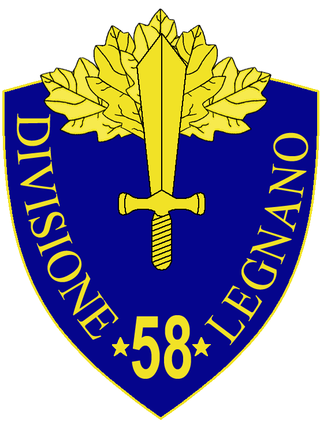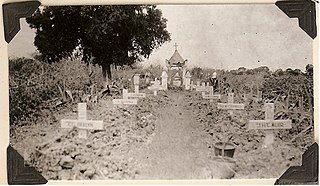Related Research Articles

The 1st CC.NN. Division "23 Marzo" was an Italian CC.NN. division raised on 23 April 1935 for the Second Italo-Ethiopian War against Ethiopia. The name "23 Marzo" was chosen to commemorate the founding date of the Fasci Italiani di Combattimento on 23 March 1919. The division took part in the Italian invasion of Egypt and was destroyed during the Battle of Bardia in January 1941.

The 4th Alpine Division "Cuneense" was a division of the Royal Italian Army during World War II, which specialized in mountain warfare. The headquarters of the division was in the city of Cuneo, and the majority of its Alpini soldiers were drafted from the surrounding Province of Cuneo - hence the division's name "Cuneense". The division participated in all Italian World War II campaigns with the exception of the North African Campaign. The division was annihilated during Operation Little Saturn by Soviet forces in January 1943.
The Italian order of battle for the Second Italo-Ethiopian War on 8 October 1935. The Ethiopian order of battle is listed separately.

The 5th Alpine Division "Pusteria" was a division of the Royal Italian Army during World War II, which specialized in mountain warfare. The Alpini are a mountain infantry corps of the Italian Army, that distinguished itself in combat during World War I and World War II. The division was formed in 1935 and based in the Puster Valley, which gave the division its name.

The 3rd Alpine Division "Julia" was a division of the Royal Italian Army during World War II, which specialized in mountain warfare. The Alpini that formed the divisions are a highly decorated, elite mountain corps of the Italian Army comprising both infantry and artillery units. Today the traditions and name of the 3rd Alpine Division "Julia" are carried on by the Alpine Brigade "Julia".

The 19th Infantry Division "Venezia" was a infantry division of the Royal Italian Army during World War II. The Venezia was classified as a mountain infantry division, which meant that the division's artillery was moved by pack mules instead of the horse-drawn carriages of line infantry divisions. Italy's real mountain warfare divisions were the six alpine divisions manned by Alpini mountain troops. The division was named for the city of Venice and based in Tuscany, from where it also recruited most of its troops. After the Armistice of Cassibile between the Allies and Italy was announced on 8 September 1943 the division joined the Yugoslav partisans in Montenegro and formed the Partisan Division "Garibaldi".

The 30th Infantry Division "Sabauda" was an infantry division of the Royal Italian Army during World War II. The Sabauda was based in Cagliari in Sardinia and named for the Latin name of the Royal House of Savoy. After the announcement of the Armistice of Cassibile on 8 September 1943 the division joined the Italian Co-belligerent Army.

The 26th Infantry Division "Assietta" was a infantry division of the Royal Italian Army during World War II. The Assietta was classified as a mountain infantry division, which meant that the division's artillery was moved by pack mules instead of the horse-drawn carriages of line infantry divisions. Italy's real mountain warfare divisions were the six alpine divisions manned by Alpini mountain troops. The division was named for the Battle of Assietta in 1747 and based in Asti.

The 2nd CC.NN. Division "28 Ottobre" was an Italian CC.NN. division raised on 10 May 1935 for the Second Italo-Ethiopian War against Ethiopia. The name "28 Ottobre" was chosen to commemorate the Fascist March on Rome on 28 October 1922. The division took part in the Italian invasion of Egypt and was destroyed during the Battle of Bardia in January 1941.

The 4th CC.NN. Division "3 Gennaio" was an Italian CC.NN. division raised on 25 June 1935 for the Second Italo-Ethiopian War against Ethiopia. The name "3 Gennaio" was chosen to commemorate the date of assumption of dictatorial powers by Benito Mussolini on 3 January 1925. The division took part in the Italian invasion of Egypt and was destroyed during the Battle of Sidi Barrani in December 1940.

The 27th Infantry Division "Brescia" was an infantry division of the Royal Italian Army during World War II. The Brescia was named after the city of Brescia in Lombardy. The Brescia was classified as an auto-transportable division, meaning it had some motorized transport, but not enough to move the entire division at once.
The Italian 2nd Eritrean Division, also known as the Second Eritrean Division or II Division Indigini (Native), was an Italian Infantry division used in the Second Italo-Abyssinian War in 1935. It was formed from the Eritrean Ascari of the Battalion indigeni (Native Battalions) who provided the regular colonial forces of Italian Eritrea.

The 3rd Cavalry Division "Principe Amedeo Duca d'Aosta" was a Cavalry or "Celere" (Fast) division of the Royal Italian Army during World War II. The division was formed in 1934, and during World War II was mobilized in June 1940. As a cavalry division it took part in the Invasion of Yugoslavia and was part of the Italian Expeditionary Corps in Russia. Annihilated during the Red Army's Operation Little Saturn in December 1942, the survivors returned to Italy in spring 1943.

The 6th Infantry Division "Cuneo" was an infantry division of the Royal Italian Army during World War II. The Cuneo was formed on 24 May 1939 in Milan by splitting the 58th Infantry Division "Legnano" and was named for the city of Cuneo. The Cuneo was part of the III Corps of First Army that took part in the Italian invasion of France, and then it was part of the XXVI Corps during the Greco-Italian War.

The 13th Infantry Division "Re" was an infantry division of the Royal Italian Army during World War II. The division was based in Friuli and entitled to the King.

The 20th Infantry Division "Friuli" was an infantry division of the Royal Italian Army during World War II. The Friuli was formed on 24 August 1939 by splitting the 20th Infantry Division "Curtatone e Montanara" into the Friuli and the 44th Infantry Division "Cremona". The Friuli was named for the region of Friuli, but based in Tuscany, where it also recruited most of its troops. The division's headquarter and its regiments, with the exception of the 87th Infantry Regiment located in Siena, were based in Livorno. The division served as occupation force on Corsica and fought German units after the Armistice of Cassibile was announced on 8 September 1943. The division then served with the Italian Co-belligerent Army and remained active into the early stages of the Cold War.

The 28th Infantry Division "Aosta" was an infantry division of the Royal Italian Army during World War II. The Aosta was formed for the first time in 1831 and named for the city of Aosta. The division fought in the Allied invasion of Sicily and its remnants were evacuated to Northern Italy, where the division's remnants were disbanded after the Armistice of Cassibile.

The 37th Infantry Division "Modena" was a infantry division of the Royal Italian Army during World War II. The Modena was classified as a mountain infantry division, which meant that the division's artillery was moved by pack mules instead of the horse-drawn carriages of line infantry divisions. Italy's real mountain warfare divisions were the six alpine divisions manned by Alpini mountain troops. The division was formed on 25 March 1939 with units of the 5th Territorial Division "Imperia" and named for the city of Modena. The division was made up entirely of men from the city of Genoa and the surrounding Liguria region. The division's regimental depots were shared with the 63rd Infantry Division "Cirene", which was based in Benghazi in Libya and recruited its men from and trained them in Liguria.

The 58th Infantry Division "Legnano" was an infantry division of the Royal Italian Army during World War II. The Legnano's predecessor division was formed on 8 February 1934 in Milan and named for the medieval Battle of Legnano. On 24 May 1939 the division split to form the 6th Infantry Division "Cuneo" and the 58th Infantry Division "Legnano". After the announcement of the Armistice of Cassibile the Legnano resisted the invading German forces. The division's staff and 67th Infantry Regiment "Legnano" were used to form the first unit of the Italian Co-belligerent Army, which fought on the allied side in the Italian campaign. On 17 February 1944 the division's last units joined other commands and the division was officially dissolved.

The Italian Somali Divisions were two divisions of colonial soldiers from Italian Somaliland that were formed as part of the Regio Esercito Royal Corps of Colonial Troops during the Second World War. In the Royal Corps of Colonial Troops, the units comprised the "101 Divisione Somala" and "102 Divisione Somala" and fought during the East African Campaign in 1941 before disbanding.
